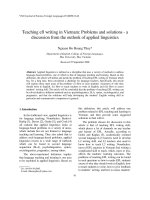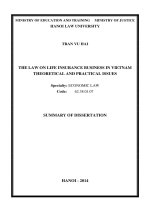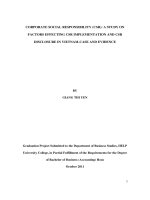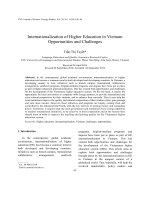Legalizing prostitution in vietnam why and why not
Bạn đang xem bản rút gọn của tài liệu. Xem và tải ngay bản đầy đủ của tài liệu tại đây (1.06 MB, 51 trang )
VIETNAM NATIONAL UNIVERSITY, HANOI
VIETNAM JAPAN UNIVERSITY
NGUYEN CONG THAI SON
LEGALIZING PROSTITUTION IN
VIETNAM: WHY AND WHY NOT?
MASTER’S THESIS
VIETNAM NATIONAL UNIVERSITY, HANOI
VIETNAM JAPAN UNIVERSITY
NGUYEN CONG THAI SON
LEGALIZING PROSTITUTION IN
VIETNAM: WHY AND WHY NOT?
MAJOR: PUBLIC POLICY
CODE: 8340402.01
RESEARCH SUPERVISOR:
PH.D. VU HOANG LINH
Hanoi, 2021
ACKNOWLEDGEMENT
This thesis of mine would not be completed without any assistance. Therefore, I would
like to express my sincerest thanks for the support and motivation during the time of
completing this thesis.
First of all, I would like to thank my mentor – PhD Vu Hoang Linh. His enthusiastic
help and valuable advice have guided me in completing and improving the quality of
this thesis. Without your help, I would not have been able to complete this thesis
effectively.
The most special thanks go to all the teachers and assistants of the Master's Program of
Public Policy. The advice and suggestions of yours during the process of completing
this thesis helped me see the shortcomings in my thesis as well as how to improve it.
I would also like to thank ILO, CEPEW, CSAGA, PhD Duong Kim Anh & PhD
Nguyen Thi Thu Huong for their advice while I was looking for an in-depth
interviewee.
Finally, I would like to express my love and respect to my family and friends who
have accompanied me throughout my studies. Thank you for always encouraging me
to pursue my master's dream, dad. I hope you can watch me finish this graduate thesis
from the above.
Hanoi, 17th June 2021,
Sincerely,
Nguyen
Cong
Thai
Son
TABLE OF CONTENTS
LISTS OF TABLES .........................................................................................................i
LIST OF FIGURES ........................................................................................................ ii
ABBREVIATION ......................................................................................................... iii
Chap 1: INTRODUCTION ............................................................................................. 1
1.1 Research Background ........................................................................................1
1.2 Problem Statement ............................................................................................. 4
1.3 Research purpose and questions ........................................................................4
1.4 Research scope and time ....................................................................................4
1.5 Research significance......................................................................................... 4
1.6 Methodology ......................................................................................................5
1.7 Structure of research .......................................................................................... 5
Chapter 2 LITERATURE REVIEW AND METHODOLOGY .....................................7
2.1 Literature review ...................................................................................................7
2.1.1 Studies on prostitution in Vietnam ............................................................... 14
2.1.2 Media coverage of prostitution legalization ................................................15
2.2 Research gap .......................................................................................................17
2.3 Legislative framework in Vietnam......................................................................17
2.4 Research flow ......................................................................................................19
2.5 Survey and in-depth interview ............................................................................19
Chapter 3 FINDINGS ....................................................................................................21
3.1 Survey result ........................................................................................................21
3.1.1 Demographic................................................................................................ 21
3.1.2 Public perception about prostitution ........................................................... 22
3.1.3 Public perception about the legalization of prostitution in Vietnam ...........23
3.1.4 Reaction to a vision where prostitution is legalized in Vietnam .................24
3.2 In-depth interview result .....................................................................................25
3.2.1 Sex workers’ perception about legalizing prostitution ................................ 25
3.2.2 Interview with lawyers .................................................................................28
3.2.3 NGO expert’s opinion on legalizing prostitution in Vietnam ......................29
3.3 Finding and discussion ........................................................................................ 30
Chapter 4 CONCLUSION AND RECOMMENDATIONS .........................................33
4.1 Conclusion ...........................................................................................................33
4.2 Policy implications .............................................................................................. 33
4.3 Limitations ..........................................................................................................35
REFERENCES ..............................................................................................................36
APPENDIX ...................................................................................................................39
LISTS OF TABLES
Table 2.1: List of countries with legal and limited legal prostitution……………11
Table 2.2: The Pros and Cons of Legalization of prostitution…………………...13
i
LIST OF FIGURES
Figure 2.1 The Facebook post about “Legalizing prostitution in Vietnam” from Tifosi
fanpage………………………………………………………………………………..16
Figure 2.2 Research flow……………………………………………………………..19
Figure
3.1
The
gender
and
age
distribution
of
survey
respondents……………………20
Figure
3.2
The
living
areas
distribution
of
survey
respondents…...…………………..21
Figure
3.3
The
income
distribution
of
survey
respondents……………………............21
ii
ABBREVIATION
CEDAW: Convention on the Elimination of All Form of Discrimination Against
Women
EU: European Union
ILO: International Labour Organization
STD: Sexually Transmitted Diseases
WHO: World Health Organization
iii
Chap 1: INTRODUCTION
1.1
Research Background
Prostitution is the most controversial profession in the world. Although this profession
addresses one of the most basic human needs: sex, it is often referred to with
discrimination, hatred, and prejudice. In any case, as it has existed for thousands of
years since the advent of mankind, prostitution will continue to thrive in the future
despite ethical skepticism as well as the extreme negative influences it brings to
society.
The cultural, political, and social diversity of countries around the world leads to
different conceptions of prostitution. All these factors lead to different decisions in
different countries regarding the legality of sex work. According to the research of
Procon.org (2018), out of 197 countries and territories worldwide, 53 countries
legalize prostitution and prostitution, and 12 countries recognize the legalization of
prostitution within a limited framework. In 53 countries where prostitution is legal,
only 15 countries recognize prostitution as a profession, guaranteed rights, and
responsibilities such as paying taxes, social insurance, etc.
The differences in policies towards prostitution in these countries are also very
diverse. For example, according to Guy (1991), it is illegal in Argentina to open a
brothel, to organize prostitution, or to profit from it, Argentina but it is illegal to do so.
Buying or selling sex is completely legal. These regulations are somewhat stricter than
those on prostitution in Austria. According to the report from the Sex-Worker Forum
of Vienna, Austria (2013), prostitution in Austria is freely organized but under control
at three levels: “Central”, “Local” and “Personal”.
We can see plenty of limitations in the legislation on organized prostitution in many
countries. Some typical cases can be mentioned such as Belize, Brazil, Cyprus,
Denmark, etc. Some countries limit the negative effects of this activity by limiting the
area where prostitution is organized, such as Argentina. According to Guy (1991), in
this country, prostitution is only recognized as legal when it takes place in areas 500
meters away from public facilities such as schools, hospitals, and churches.
1
In countries where the restrictions on prostitution are stricter, the limits on regulatory
laws are also different. According to House Government Bill C-36 issued in 2014 of
Canada, prostitution is legal but buying sex is not. In another attempt to combat human
trafficking, members of the Icelandic parliament passed legislation providing for bans
on buying individuals for purposes of prostitution. This is considered as one of the
great strides in limiting the negative effects of prostitution in this country.
In some other countries, prostitution is completely banned but still going strong. The
most typical example can be mentioned Thailand. In Thailand, prostitution is
completely banned under the Prevention and Suppression of Prostitution Act B.E.
2539 released in 1996. However, Thailand is still famous for sex tours or sex tourism.
According to a report by Havocscope in 2015, the prostitution market in Thailand
reached a size of $6.4 billion a year, contributing 3% of the country's GDP. This is the
result of poor local governance at the grassroots level and severe corruption in law
enforcement agencies such as courts and police.
The situation of promulgating laws as well as policies to control activities related to
prostitution poses a need to update the legal system as well as regulations and policies
in Vietnam to become more relevant and up-to-date world direction. In addition, the
worrying growth of prostitution in Vietnam in terms of both scale and complexity has
raised controversy over whether to legalize prostitution in Vietnam.
According to the Prime Minister's Decision No. 361 / QD-TTg dated March 7, 2016,
on the Prostitution Prevention and Control Program for the 2016-2020 period: The
current situation of prostitution in Vietnam is complicated and developing
dramatically. With the booming of technology and communication, prostitution
activities now have more methods to execute and it becomes more challenging for the
public government to follow and take control of. This document also mentions the
report of 63 provinces and centrally-run cities, currently, the number of sex workers
with management records is 11,240 people, of which, concentrated in some areas such
as Red River Delta: 3,673 people.; Northeast: 913 people; North Central: 887 people;
Southeast: 3,200 people; Mekong River Delta: 1,374 people; 1,189 people in other
areas. However, the actual number may be even higher since this is a difficult activity
to control due to its complexity, sophistication, and disguise.
2
New types of prostitution activities and subjects are emerging: call girls, sex tourists,
foreigners selling sex, male sex workers, gay sex workers, transgender sex workers,
online prostitution brokers internet, Facebook,... The situation of sex workers using
drugs tends to increase; sex buyers of many different ages and groups, including those
who have no stable jobs, are self-employed: 75.7%, enterprises: 20%, officers,
employees: 3 %; 80% of owners, brokers are from 18 to 25 years old; Over 40% of the
owners are women. In cities, the re-emergence of prostitution venues in public areas,
adversely affecting the cultural environment, fine customs, and traditions, affecting
social order and safety, causing frustration in public opinion.
With prostitution in Vietnam becoming more difficult to control and complicated,
many suggestions on the legalization of prostitution have been made. The arguments
in favor of legalizing prostitution were raised such as: reducing the HIV infection rate,
policy revenues coming from tax, reducing rape crime, managing prostitution, and
addressing basic human needs. Besides, there are objections for reasons such as
violation of the constitution, the lax in the ability of the executive to manage the law,
and the violation of fine customs.
According to Tien Phong News, on January 29th, 2013, in a meeting with the press,
Mr. Le Duc Hien - Deputy Director of the Department of Social Vices Prevention
affirmed "Definitely not legalizing prostitution". He said that in Vietnam, the people's
customs, habits, lifestyle, and sense of law observance do not allow prostitution to be
legalized or recognized as a profession. His statement also partly shows the will and
thinking about the legalization of prostitution of the Communist Party of Vietnam as
well as relevant law enforcement parties. This statement is consistent with the articles
of the Constitution on marriage "One husband, one wife".
However, the necessary situation of considering the legalization of prostitution as well
as proposing to overcome the inconsistencies in the legal decrees issued to regulate
and manage sex work in localities requires further research and careful consideration.
However, research on this issue is still limited. There are not many in-depth studies to
analyze the negative side as well as the benefits of legalizing prostitution in Vietnam
under different angles such as Economy, policy, social security, human rights, and fine
customs. This study is designed to partly answer the existing problems of this topic.
3
1.2
Problem Statement
With the current situation of prostitution and prostitution brokerage activities in
Vietnam, opinions about the legalization of prostitution in Vietnam are creating a
wave of controversy among the community. This is also an issue that needs to be
concerned and debated by law researchers as well as policymakers. By considering
whether or not prostitution is legal, there are many loopholes in the management of
this sensitive activity being explored.
1.3
Research purpose and questions
The research's target is answering the question "Shall prostitution be legalized in
Vietnam?". The following sub-questions will give the final answer an overview and
diversified perspective:
-
How does the public audience think about legalizing prostitution?
-
Does legalizing prostitution protect and improve the lives of sex workers?
-
Are there any adverse consequences caused by legalizing prostitution in
Vietnam?
1.4
Research scope and time
Regarding the time scale, the data collected and published by Government are from
2016. The data collected by survey and in-depth interviews are from March 2021 till
April 2021.
1.5
Research significance
Regarding academic significance, the research hopes to contribute an overview of how
the public audience thinks about the legalization of prostitution in Vietnam and the
opinion of both sex workers and law enforcement people on the consequence and
benefit of the issue. In-depth interviews with different stakeholders would give an
insight of sex workers on their situation during working in the most sensitive and
illegal industry. By considering their view, the policymakers and researchers may find
out new ideas on how to alleviate the current situation in Vietnam.
For social significance, the research is hope to contribute another view and research
result based on the voice of different stakeholder and raising the awareness on
prostitution - its impact to society. Moreover, the concentration on sex laborers’ rights
4
and needs of this research could help them speaking out the inner fear of the industry
and insecurity about the financial problem they are facing with.
1.6
Methodology
This research uses the qualitative method. The thesis will delve into the study of
academic materials by desk research. This helps to point out the right direction and
approach to the problem. To further clarify and develop approaches to the problem,
two types of surveys will be conducted. A survey on public audience's evaluation on
the idea of legalizing prostitution in Vietnam with 100 participants. The participants of
the survey on public audience come from all over the countries, divided into three
main categories: big cities (Hanoi, Danang, Ho Chi Minh), around big cities, and other
areas. They are from 18 years old to 50 years old, having different incomes per month.
The survey focuses on exploring their opinion on the idea of the legalization of
prostitution in Vietnam. To diversify the key players in the field, the in-depth
interviews were processed with 5 participants: 2 of them are lawyers, 2 are sex
workers, and 1 NGO expert. All of the participants are interviewed separately to
ensure their opinion.
1.7
Structure of research
The thesis will contain four chapters with the content as follow:
Chapter 1: Introduction.
This is the chapter where the research background is emphasized and the research
questions are clarified. This part also mentions other things like the research
methodology and significance of the research.
Chapter 2: Literature review and methodology.
This chapter focus on analyzing academic researches on legalizing prostitution in the
world, the relationship between prostitution legalization and human trafficking, and
the current situation of prostitution in Vietnam. Legislation documents and legal
frameworks for prostitution in Vietnam are also carefully reviewed in this part.
Another important subject of this chapter is the methodology and theoretical
framework adopted in the research.
5
Chapter 3: Findings.
This chapter illustrates and evaluates the findings resulting from both surveys and indepth interviews. The data will be analyzed and discussed.
Chapter 4: Conclusion and recommendations
The final chapter of the thesis summarizes all the findings, discussion from the
research. Based on those results, recommendations for the laws of prostitution in
Vietnam would be given.
6
Chapter 2 LITERATURE REVIEW AND METHODOLOGY
2.1 Literature review
Although the status quo of prostitution is always a burning issue for society and
needed to be addressed in many places - especially in countries where prostitution is
legal, the promulgation of regulations on this issue is still ongoing. This is a sensitive
issue in any region of the world. Even in Europe - the continent with the most
countries legalizing prostitution in the world, the promulgation of legal tools or
common regulations for this activity has not received the attention of The European
Union (EU). Allwood (2018) researched to delve deeper into why there is still no
specific EU policy on prostitution. Although there are many EU regulations and
unanimous statements on gender equality and human rights, there is no specific
regulation on prostitution, even though this is an issue closely related to gender
equality. With the desk research method, referring to a lot of information from reports
from EU meetings and decrees, Allwood (2018) found difficult issues in the process of
making a common regulation for prostitution in Europe. EU countries' avoidance of
regulation of prostitution is not the result of passivity but initiative and repetition of
ignorance. The deeper cause comes from the policy thinking of the politicians of the
members of the EU. Each country in the EU has its regulations and standards for
prostitution, so bringing this topic up for discussion and discussion will take a lot of
time to come to a common conclusion or agreement. In addition, for the EU, there are
many other issues more important to discuss than prostitution. Although relevant
issues such as illegal human trafficking - an issue closely related to prostitution - are
considered and agreed to for policy enforcement, prostitution remains a sensitive area
for the EU to avoid handling. Coming up with a policy for prostitution has been
fraught with difficulties and failures right from the start of creating an agency that is
strong, impressive, and effective enough to attract the EU's attention in joint
conferences. The author also gives suggestions on the direction for the promotion of
policy on prostitution in the EU. This only makes progress when relevant units
promote their activities in the organization. For example, the EU-affiliated women's
unions need to step up their lobbying activities and create a more effective approach
and problem-solving for the whole organization through side forums and seminars to
7
raise their goals and the benefits of promulgating a common regulation for prostitution
in the EU. However, it will still take a lot of time and effort to make prostitution and
its policymaking a matter of concern in the EU.
Digging deeper into the issue, Jonsson and Jakonsson (2017) conducted a study on
public attitudes towards prostitution in eight EU countries. The authors assert that
there is a close relationship between public attitudes about prostitution and the sex
market. In countries where prostitution is illegal, people have fewer positive attitudes
towards prostitution than people in countries where prostitution is legal. The scale of
prostitution also affects public attitudes. Residents in countries where brothels are
allowed are more open to prostitution than residents of countries where brothels and
prostitution are prohibited. In the opposite direction, there is the impact of public
attitudes on the decision to enact legislation on prostitution. In particular, the most
common reason for curbing prostitution is combating human trafficking. Policymakers
believe that criminalizing prostitution will reduce demand for this service. Since then,
the supply of sex workers has been reduced; leading to the decline of human
trafficking. But it is also important to recognize and evaluate Sweden's success in
managing and mitigating the adverse effects of prostitution. According to Ekberg
(2004), this success stems from the public opinion that prostitution is an activity that
affects women's rights. When human rights and gender equality are upheld, in a
country where prostitution is legalized like the Netherlands, prostitution is considered
a profession, and sex workers enjoy the same labor rights as other professions.
The impact of human rights organizations can change and influence policy action
related to prostitution. In Norway, the relentless fight against prostitution by women's
rights organizations for 30 years has resulted in a total change in policymaking related
to this issue. Activities against the act of buying and selling sex services began in 1980
with discussions and statements from the Norwegian Women's Union. These relentless
efforts have brought positive results for them when in 2006, the Norwegian
Confederation of Trade Unions Congress issued a draft to criminalize prostitution and
the sale of sex services. However, this is not entirely an objection to sexual activity.
Their goal is to fight for a healthy working environment, protect the rights and
interests of sex workers. Strom (2009) summarizes the entire process of fighting for
8
women's rights as well as opposing prostitution activities during 30 years in Norway in
a research paper. Strom concludes, the results after 30 years are a combination of
many factors, the most important of which is a methodical struggle. Organizations
defending human rights and women's rights have called for the voices of many related
organizations. They use voices from the international community to raise issues. Then,
mobilize consensus from the National Assembly deputies and important figures related
to this issue. Recognizing the economic benefits that prostitution can bring, having
The Trade Union as an ally is seen by Strom as a major victory for the movement as a
whole. That's huge political backing. The long road of struggle brought victory when
the law providing for the punishment of prostitution was enacted in Norway on
January 1st, 2009.
Another example of restricting prostitution in Canada. In 2014, the Canadian
Parliament officially passed a law criminalizing prostitution. According to Johnson
and Porth (2020), this is a result of the difficulty of controlling this activity at all levels
of government. Even when the Prostitution Act was enacted in 2014, this is still not a
solid basis for the control of prostitution in Canada. According to the author, to have a
strict control system of many parties is not only the independent participation of the
state management apparatus. Stakeholders also include local people's councils, which
directly listen to community feedback. In addition, the enactment of a policy to restrict
the activities of prostitution also met with opposition from both inside and outside the
government. Activists to protect gender equality consider this as an outbreak without
careful preparation, causing certain injuries to people who are working as sex workers.
But does the introduction of a law banning prostitution make the lives of sex workers
worse as they face more rigor from both sex brokers and the law? Bilardi et al (2010)
studied the job satisfaction of female sex workers in licensed brothels in Victoria,
Australia. Out of 112 survey samples, only one-quarter feel comfortable and satisfied
with the work they are doing. The rest work for the sole reason of solving financial
problems, not enjoying the work they have. The reason for dissatisfaction with work
comes from the bad working environment as well as the prejudices of society for them.
Even so, it is difficult for them to find another job that can provide them with a greater
income than prostitution.
9
Another case worth considering is Spain. The country has a smokeless industry with a
contribution of 3.6 million euros to the national economy. Prostitution was
decriminalized in 1995, but prostitution such as prostitution, brothels, or human
trafficking is completely banned. However, Villacampa and Torres (2013) evaluate
that Spain still needs to put a lot of effort to achieve the expected environment for
controlling prostitution. Spain's soft policy and control tools have revealed many
weaknesses in the management of this type of business and they are proved by reality
to be ineffective.
Practice shows that there are many problems and problems in promulgating a set of
framework regulations for the management and control of prostitution in any country
in the world. Efforts to introduce prostitution in countries are mainly focused on the
main goal of reducing human trafficking. Choi et al (2013) have shown a close
connection between human trafficking and the legalization of prostitution in many
countries. Specifically, in countries where prostitution is legal, the variability of
trafficking varies with the size of the sex market. However, it is difficult to accurately
quantify the interaction between prostitution and human trafficking due to the lack of
accurate data.
Not only human trafficking, but prostitution also brings extremely serious
consequences to the law enforcement system in countries with weak management
systems. Petras and Wongchaisuwan (2016) explore the dark side of the market,
AIDS, and child prostitution in Thailand. They assert that the sex-tourist industry is
the engine that drives the miraculous development of the economy in Thailand. Even
though prostitution is completely banned in this country, it is terrible corruption and
market manipulation that makes the situation of prostitution in Thailand serious and
extremely complicated. Thousands of brothels and entertainment venues not only sell
sex services but are also a source of STDs and AIDS. The indifference and weakness
at the top of the management apparatus create holes for human trafficking to flourish
and pushes many children into the dirty industry.
In general, the laws, regulations, as well as policies on prostitution in countries around
the world, are different and highly complex. It is difficult to say that a country has a
regulation that supports or opposes prostitution based on the actual situation.
10
Therefore, when assessing the policy on prostitution can be put into three forms:
“Legal” and “Limitedly Legal”.
Table 2.1: List of countries with legal and limited legal prostitution
Legal
1. Argentina
2. Austria
3. Bangladesh
4. Belgium
5. Belize
6. Bolivia
7. Brazil
8. Bulgaria
9. Chile
10. Columbia
11. Costa Rica
12. Cuba
Limitedly Legal
1. Armenia
2. Australia
3. Canada
4. France
5. Iceland
6. Ireland
7. Japan
8. Malaysia
9. Norway
10. Sweden
11. United Kingdom
12. United States
13. Cyprus
14. Czech Republic
15. Denmark
16. Dominican Republic
17. Ecuador
18. El Salvador
19. Estonia
20. Ethiopia
21. Finland
22. Germany
23. Greece
24. Guatemala
25. Honduras
11
Legal
Limitedly Legal
26. Hungary
27. India
28. Indonesia
29. Israel
30. Italy
31. Kenya
32. Kyrgyzstan
33. Latvia
34. Luxemburg
35. Malta
36. Mexico
37. Netherlands
38. New Zealand
39. Nicaragua
40. Panama
41. Paraguay
42. Peru
43. Poland
44. Portugal
45. Senegal
46. Singapore
47. Slovakia
48. Slovenia
49. Spain
50. Switzerland
51. Turkey
52. Uruguay
53. Venezuela
Sources: Prostitution.procon.org
12
The reality from countries all over the world shows the good and bad sides of
legalizing prostitution, these will be important points to consider whether to legalize
prostitution in Vietnam or not.
Table 2.2 The Pros and Cons of Legalization of prostitution
Pros
Cons
Gender equality - Protect the right to work as a
and
human
rights
- May cause corruption and
ineffectiveness
sex worker of women
- Protect sex workers from the
risk of violence, harassment,
in
incomplete
an
unready
governing system
and discrimination
Economic
- Create new contribution to
the economy and reduce the
- May cause corruption and
ineffectiveness
in
incomplete
tax loss
an
unready
governing system
Moral value
- Improve
the
public
perception of prostitution,
- Degrade
the
value
of
humanity as the human body
now can be traded as goods to
free choice to work
supply services
Human
trafficking
- Make
it
easier
for
sex
workers to report abuse to
Prevention
- Control the HIVs epidemic
more
trafficking to fulfill the rising
demand
police
STDs
- Increase the inflow of human
effectively
as
the
government may encourage
and promote the use of
condom and public health
center
in
- May cause operating and
economic
ineffectiveness
since it takes days to weeks
for the STDs test’s result to
be available
prostitution
activities
13
Referring to the situation of prostitution management in other countries, to develop an
effective prostitution management policy framework, there are three important factors:
-
Management level of the government
-
An approach to addressing the issue of prostitution management
-
Public opinion on issues related to prostitution
These are factors that can be used to refer to and evaluate whether prostitution should
be legalized in Vietnam.
2.1.1 Studies on prostitution in Vietnam
In Vietnam, research articles and discussions focus on the exploitation of sex workers'
risk of STDs and HIV rather than gender equality and policy aspects. Ngo et al (2007)
studied the lives of female sex workers in Vietnam through thirty in-depth interviews
and sex workers groups operating in two big cities, Hanoi and Ho Chi Minh. The
results of the study show that female sex workers in Vietnam are limited in options to
protect themselves from the risks posed by their work. Sanctions and regulations
empower and protect the interests of other key players such as clients and sex brokers
rather than sex workers. The relationship between sex workers and sex brokers
completely determines the rate at which they are violated, exploited, or assaulted. The
loop of financial problems - sex workers make it difficult for them to escape. Even
when there is a need to give up prostitution and find another profession, there are
many barriers that prevent them from redirecting and changing their lives such as
social prejudices, financial problems, threats of sex brokers and gangs, etc. As soon as
they decide to work as a sex worker, they don't have enough information and
awareness about the "fait accompli" situation they are about to enter. Prostitution is not
a difficult profession to start, but giving up requires more than a quid pro quo. De
facto, there isn't much help from society and the government for sex workers.
A more up-to-date study by Nadol et al (2017) indicates a high risk of HIV
transmission between sex workers and sex buyers. Despite the decline in HIV
infection rates over the past 10 years in Vietnam, the rate of HIV transmission through
sex work has remained high. This is the result of a lack of control and laxity in
propaganda and the improvement of prostitution in Vietnam.
14
2.1.2 Media coverage of prostitution legalization
Law Newspaper of Ho Chi Minh City (2018) quotes a member of the National
Assembly on the issue of "Legalizing prostitution" as follows: "Don't look at
prostitution only from the perspective of fine customs and traditions. The problem of
prostitution, which has existed for thousands of years, is it pure culture or custom?”
Specifically, at the seminar "Should prostitution be recognized as a profession held on
April 5, 2018, standing member of the Committee for Social Affairs of the National
Assembly of Vietnam - Mr. Luu Binh Nhuong gave his opinion on whether to legalize
prostitution or not. This is one of the opinions on legalizing prostitution received from
an individual who holds an important position in the National Assembly of Vietnam.
In his own opinion, prostitution should be considered a special profession, requiring
special management regulations. It would be better to approach the issue from this
perspective than to let the prostitution business freely run its course.
In addition, for him, when assessing the feasibility of legalizing prostitution, it is not
only considered solely from a customary perspective. He said that this is an activity
that has appeared and existed for thousands of years, in both genders: men, women,
and even homosexuals. The current management sanctions are not appropriate and
keep up with the development of this activity.
On the website of the “Báo điện tử Đảng Cộng Sản Việt Nam” (2018) - the official
news agency of the Communist Party of Vietnam, Mr. Cao Van Thanh, Deputy
Director of the Department of Social Vices Prevention (Ministry of Labour, War
Invalids and Social Affairs) commented, sanctions for administrative violations with
prostitution are not fair as there is no specific policy to deal with sex buyers.
According to him, the regulations about the prevention and management of criminal
acts relating to prostitution are not feasible with the actual situation. Penalties for
prostitution are not strong enough and inadequate. He said that the development of the
policies on prostitution is based on the viewpoint of institutionalizing the view that
prostitution is illegal in Vietnam. However, the development of policies and laws on
prostitution prevention and combat will ensure respect for human rights, focusing on
social solutions, to reduce the harm caused by prostitution to the government. sex
workers and society, contributing to the stability and development of the country.
15
Also in this article, Dr. Tran Van Dat, Deputy Director of the Department of General
Legislative Affairs (Ministry of Justice) shared the same opinion with Mr.Luu Binh
Nhuong that the development of a law on prostitution should be gradually oriented
towards the vision where prostitution is considered a profession. According to him, the
government should recognize prostitution and organize the management of prostitution
activities in separate zones like some countries and around the world. Only then can
Vietnam manage and minimize the transmission of sexually transmitted diseases.
There has been a lot of participation and input from those who can make decisions and
influence the making of policies on prostitution in Vietnam. This is one of the
important highlights during the explosive debate about “Should prostitution be
legalized or not?”. On social networks, the controversy also took place fiercely on
many pages with the participation of sharing opinions from the community. The
comments from the public mainly revolved around the advantages and disadvantages
of legalizing prostitution in Vietnam. The perspectives and approaches to the problem
are also very diverse: ethical perspective, level of management, legal feasibility, social
safety, public health, human trafficking, etc. Typically, the analysis shared on the
Tifosi page on Facebook (2020), attracted more than 8100 reactions, 945 comments,
and 634 shares. This is an impressive number, showing interest in this controversial
issue.
16
Figure 2.1 The Facebook post about “Legalizing prostitution in Vietnam” from Tofosi
fanpage
Source: Tofosi fanpage
2.2 Research gap
There are not too many studies and discussions going into analysis of policies and
legal activities related to prostitution in Vietnam. The lack of research and analysis
articles leads to gaps in the law and policy on this issue. Many things in the law no
longer respond to the changing and current situation of society. This is also the
research gap that this thesis aims to: consider the legalization of prostitution in
Vietnam from different angles to provide an update on the general situation and
recommendations for legislation related to this issue.
2.3 Legislative framework in Vietnam
Practice shows that, after 17 years of implementation, the 2003 Ordinance on
Prostitution Prevention and Control (the 2003 Ordinance) has revealed many
limitations and inadequacies that affect the work of prostitution prevention and control
in Vietnam. There are no comprehensive policies and measures to protect sex workers
from the risk of violence. The interventions, supporting community integration for sex
workers have not been effective and limited.
Over the years, Vietnam has implemented many programs related to prostitution
prevention and control, harm reduction interventions, and support for sex workers to
reintegrate into the community. However, with the increase in the proportion of sex
workers and the increase in the number of sensitive service businesses, the assessment
of the current law provisions and the implementation of activities and programs is
difficult. Thereby, proposing solutions to improve policies and laws will be important
in protecting the rights of sellers. Supporting the sex workers can be processed through
supporting them to integrate into the community, contributing to changing perceptions,
and eliminating stereotypes about sex workers.
The current law has a lot of provisions that make sex workers a crime that ignores the
responsibility of the sex buyer. According to the provisions of the 2015 Criminal
Code, revised in 2017 (the 2015 Criminal Code), sex workers can be victims of crimes
17
such as rape (Article 141); Crime of raping a person under 16 years old (Article 142);
Crime of rape (Article 143); Crime of raping people from full 13 years old to under 16
years old (Article 144); Crime of using people under the age of 16 for pornographic
purposes (Article 147); Crime of human trafficking (Article 150). However, from the
point of view that prostitution is illegal and does not have a coercive nature in sex, sex
workers are often not considered victims of rape or fornication. In particular, sex
workers often have feelings of guilt and shame and do not dare to report violent cases
related to them to competent authorities.
Sex workers may be subjected to economic or emotional violence from sex buyers,
individuals, or organizations that protect prostitution, brokers, or take advantage of
service businesses to do prostitution. The 2013 Constitution affirms that all citizens
have the right to life, the right to safety of life, health, body, honor, and dignity. These
constitutional rights have been concretized in the Civil Code 2015. However, in
practice there are acts of economic pressure, for example, lending money and
pressuring them to sell sex to repay debt and interest, is such conduct considered
economic violence and entitled to claim protection under the Civil Code?
In cases where sex workers suffer physical violence and the extent of their injuries,
they can request legal protection under Article 134 of the Criminal Code 2015: Crime
of intentionally causing injury or causing harm to the health of the sex worker.
Also, according to the Criminal Law, individuals who directly perform erotic, sexually
provocative acts, have male-to-male, female-to-female sexual relations, including
male-to-male, female-to-female collective relations that do not fall under the definition
of "prostitution". Because, to define prostitution, it must take place an act of
intercourse, which the nature of intercourse has traditionally been understood as a
sexual relationship between a man and a woman. Same-sex sex is still not understood
as "copulation" as it is commonly understood. Therefore, a loophole for cases where
the sex workers share the same gender as the buyers. Because there has not been an act
of sexual intercourse, it is not possible to handle homosexual prostitution for
prostitution-related crimes or handle administrative violations against the head of a
service business for prostitution that occurs at the facility itself.
18









